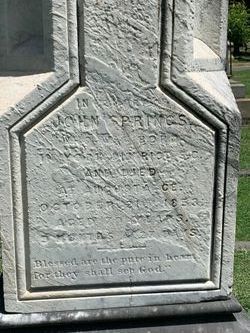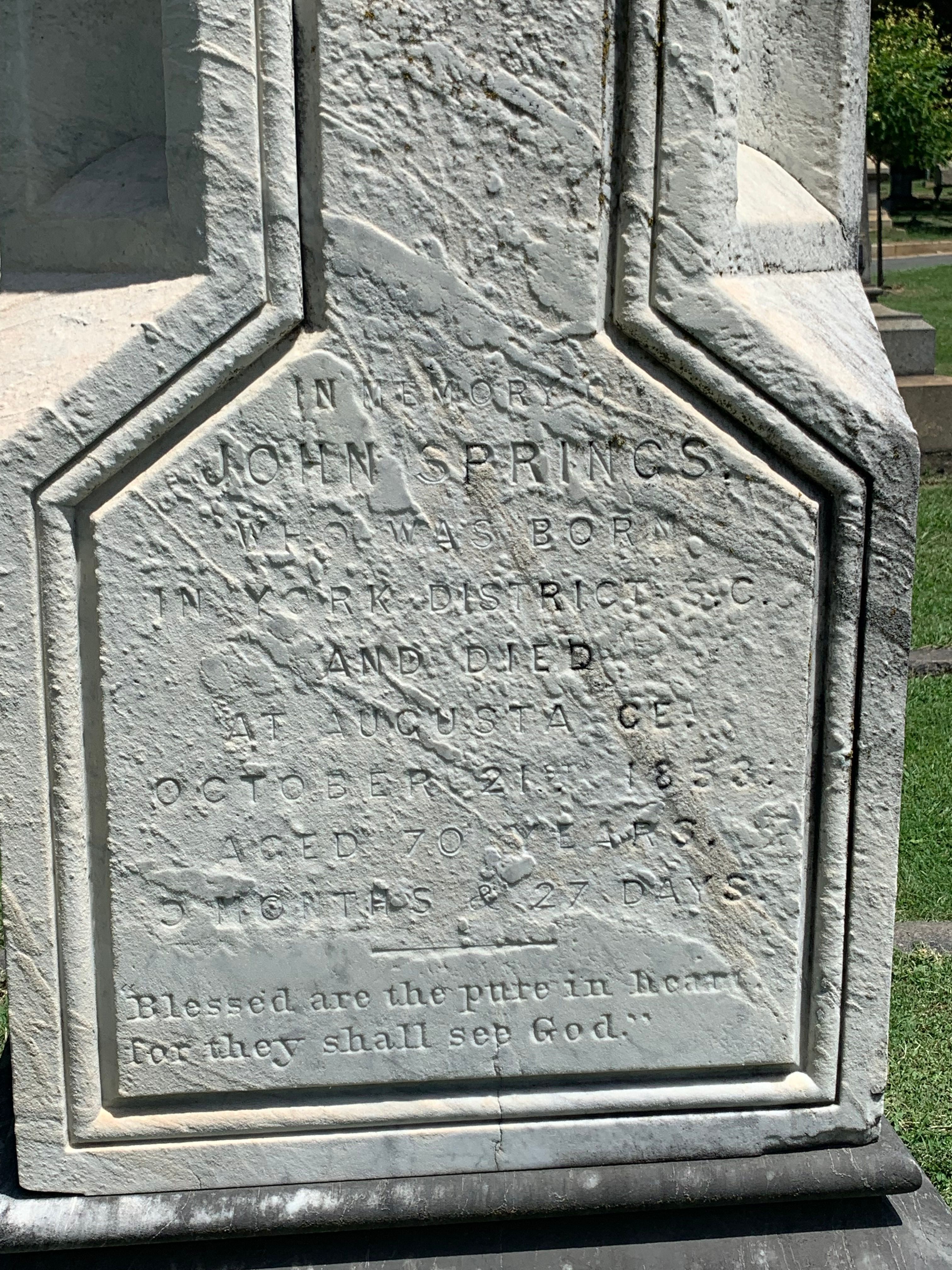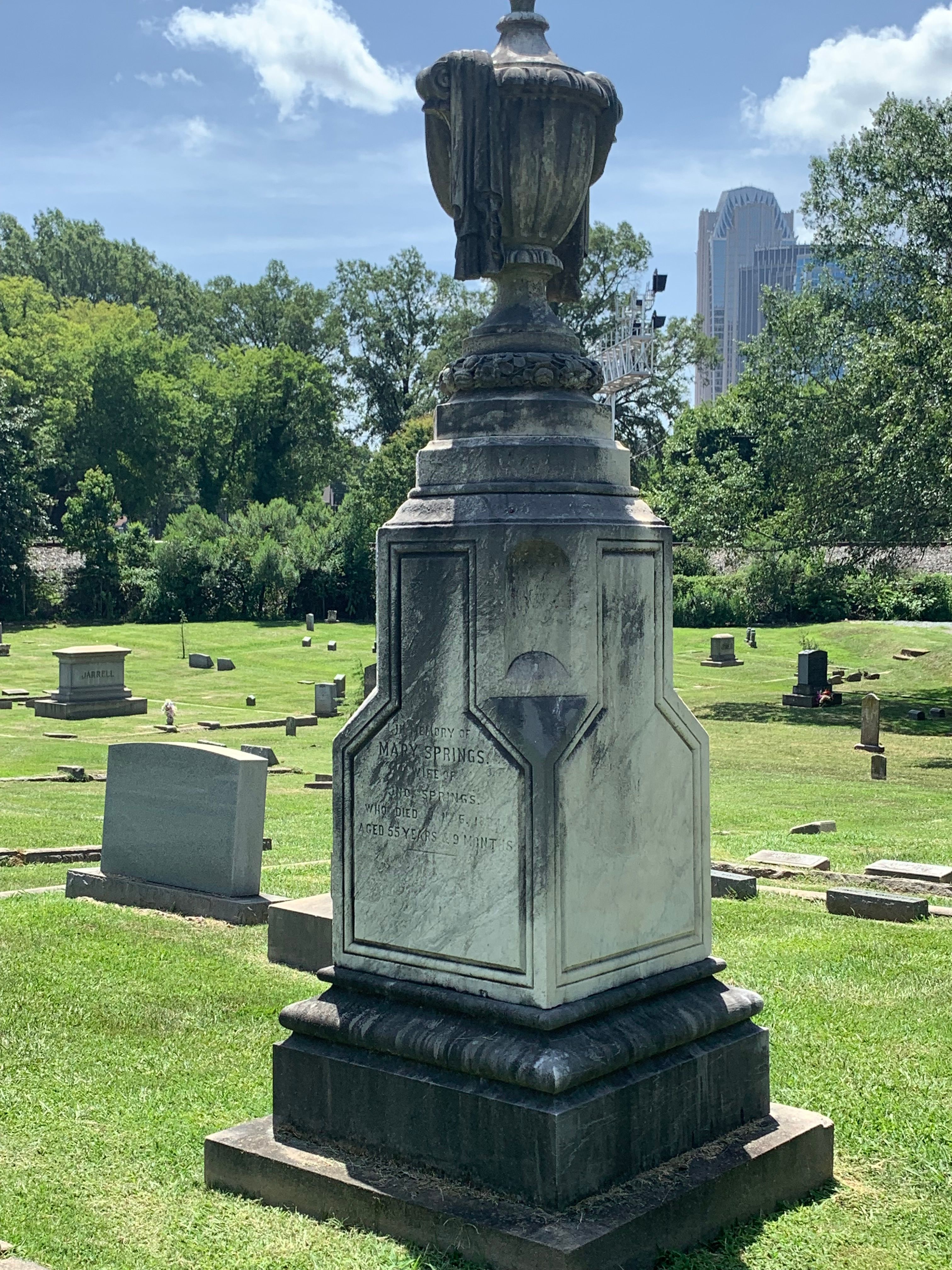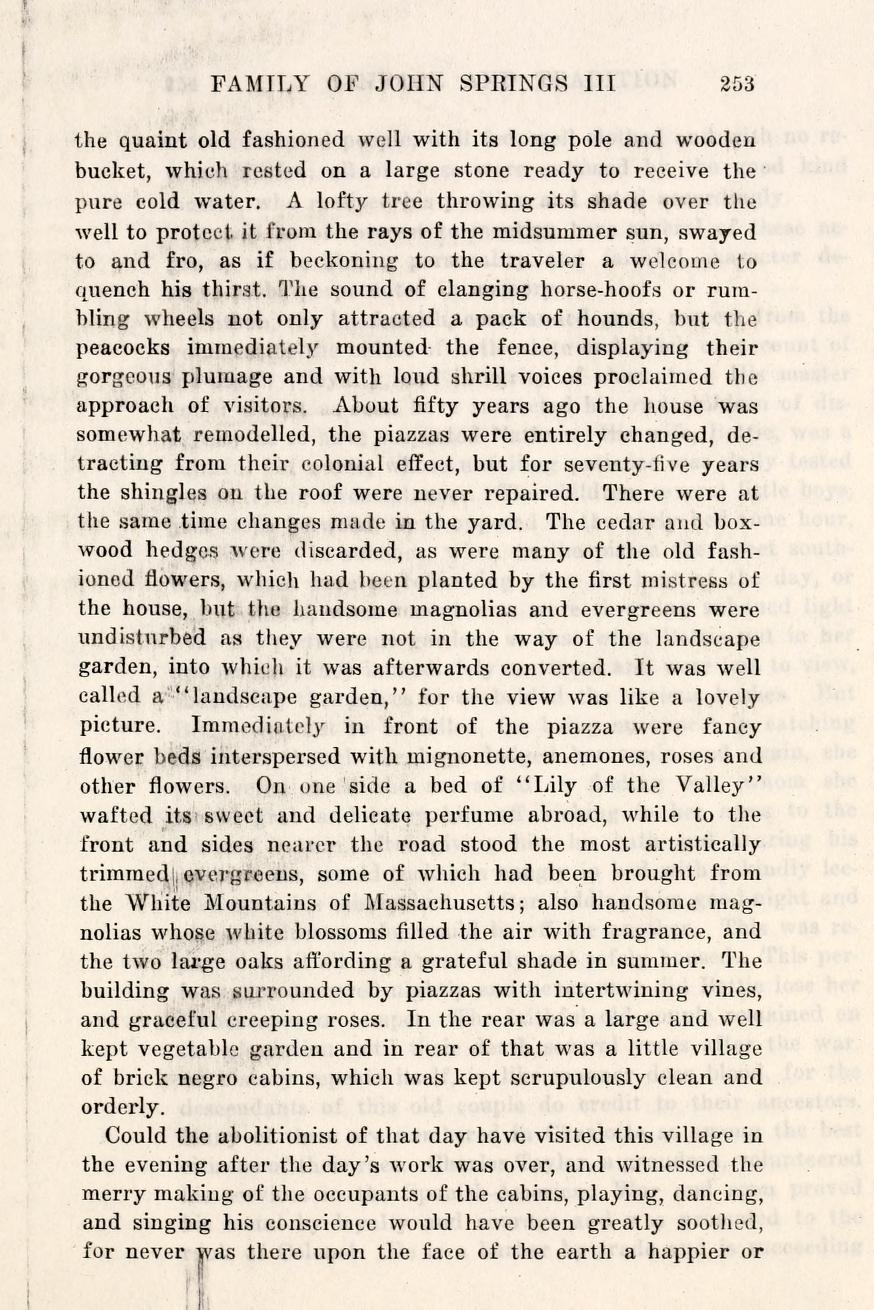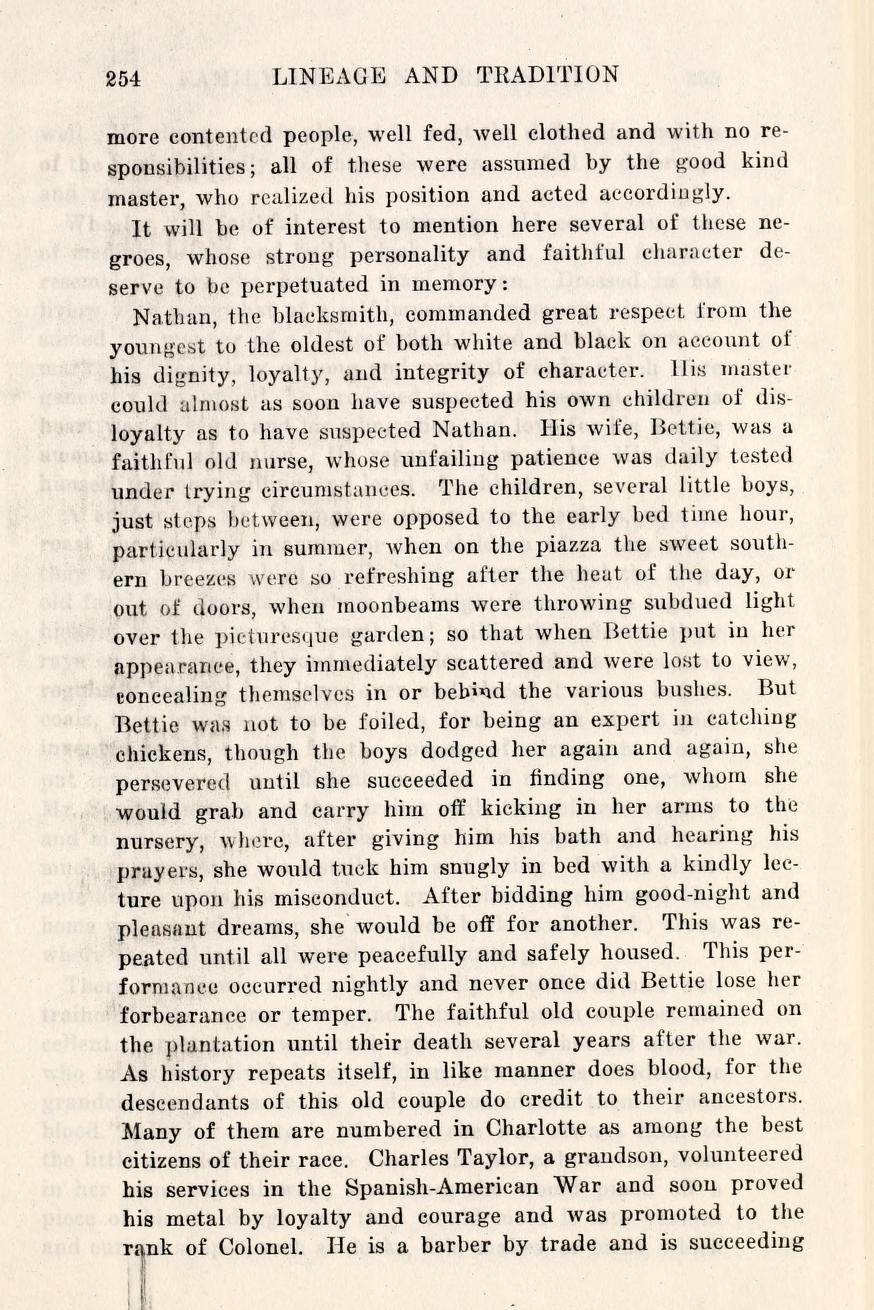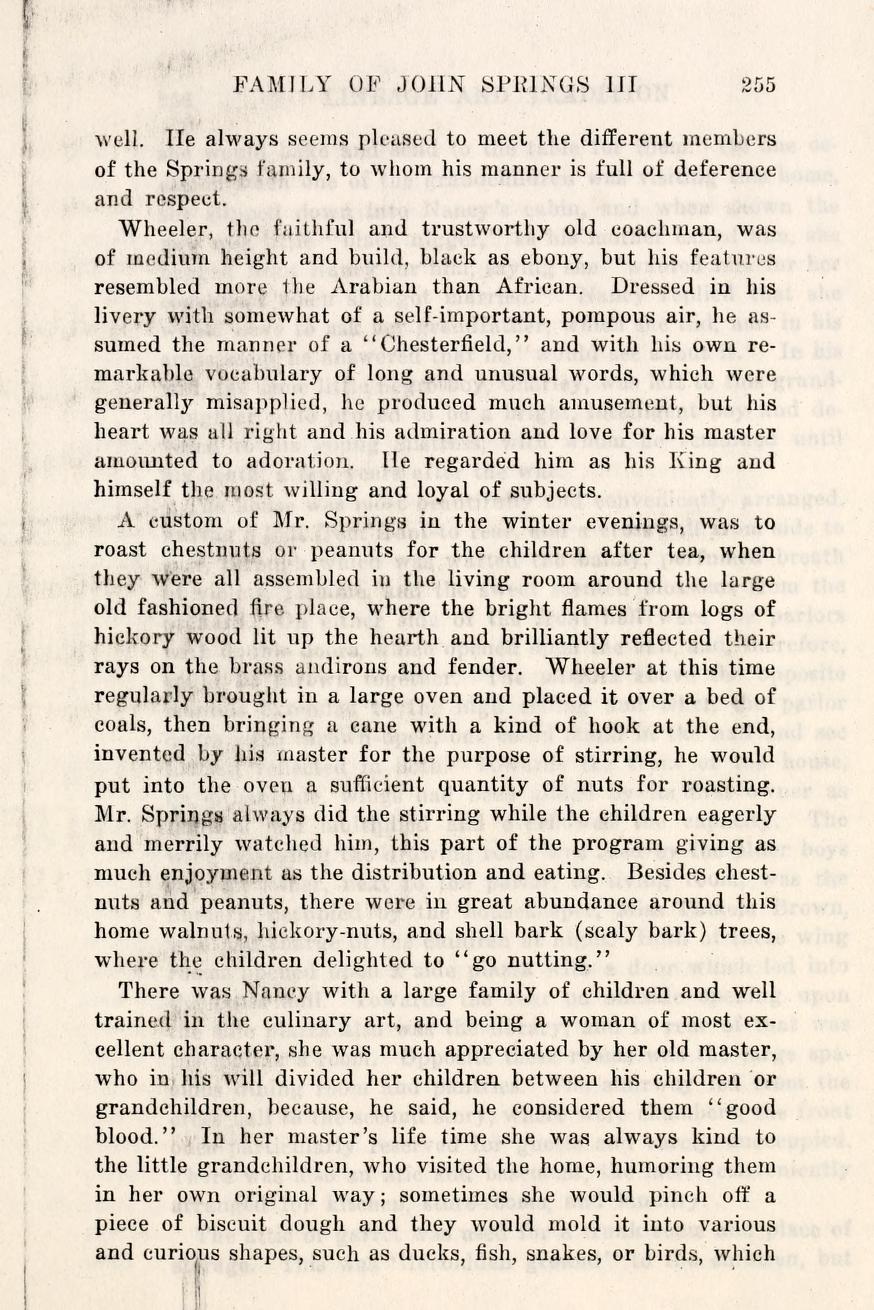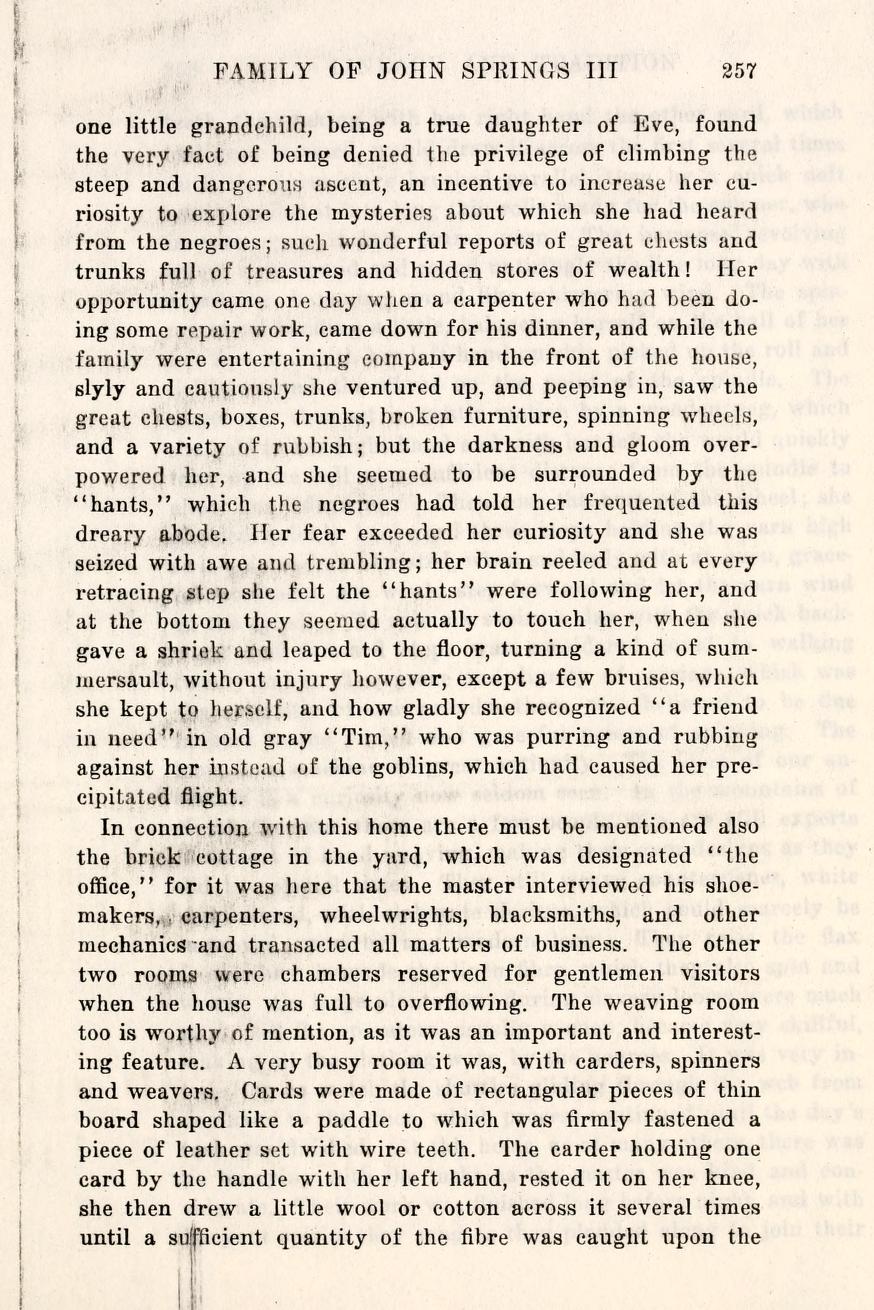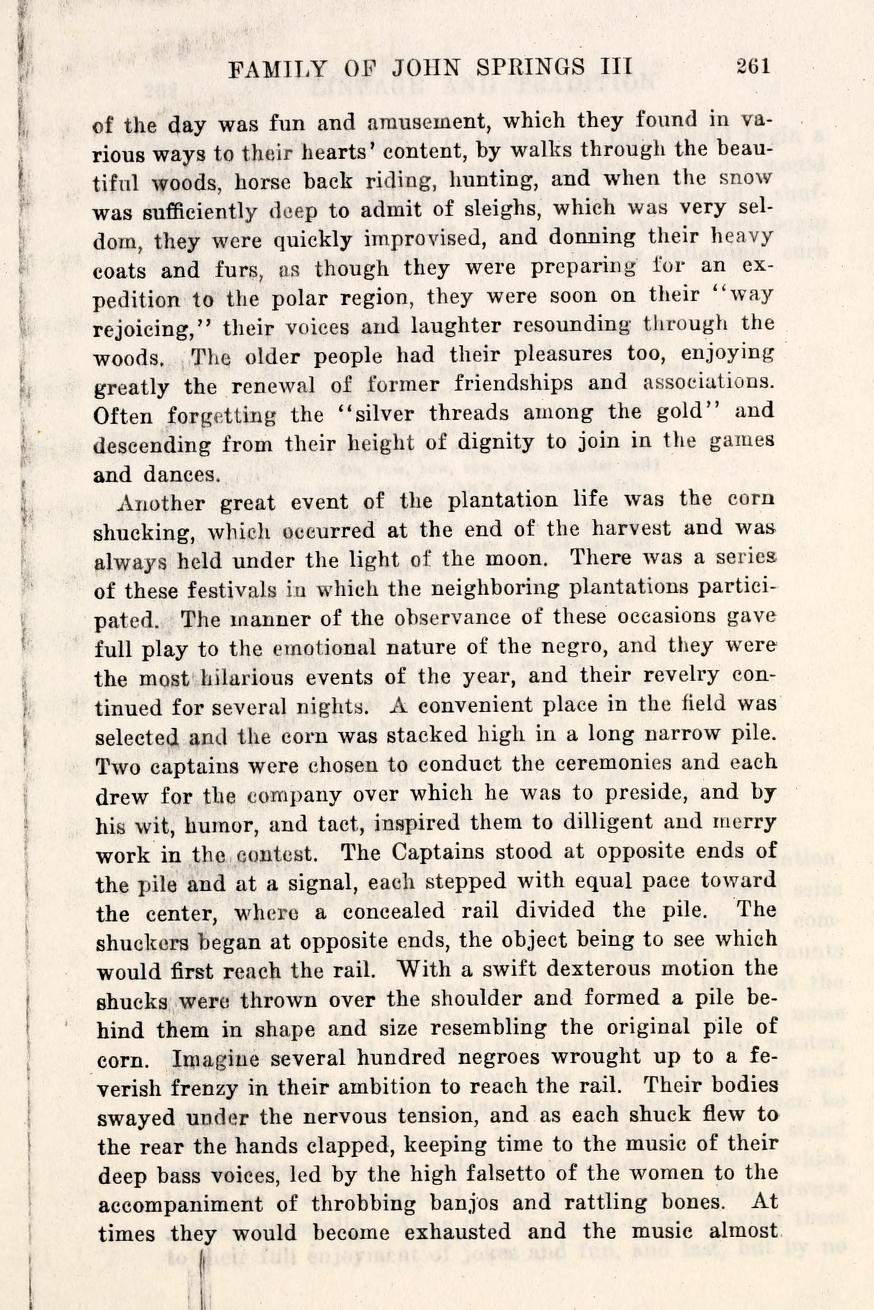John Springs III ... for much of the antebellum period was one of the wealthiest, most prominent, best respected, and most politically significant citizens of York District. He was also for at least thirty years (1806-1836) an active long distance slave trader, and even in his late sixties he continued to associate with major slave traders and to invest in their enterprises. Indeed, his long slave-trading career spanned some of the most active years of South Carolina's slave importation from other states; it extended from the mid-1830s into South Carolina's phase of slave exportation to newer cotton states. From at least 1806, when he was still in his early twenties, Springs began making regular treks from South Carolina to the Eastern Shore of Maryland, where he bargained with local farmers and owners and assembled his coffles of slaves. From Maryland (and sometimes Virginia), he marched his slave gangs, mostly in chains and ropes, to South Carolina, where he found local farmers willing to pay high prices. In buying his slaves, Springs would have broken slave families routinely, but his South Carolina clients often would have seen him as a saviour, bringing the labor that they felt was essential for their economic success.
The Springs case is of wide importance because it forms part of a general pattern. Despite his very extensive activity as a slave trader, a late-nineteenth century biographical directory, Cyclopedia of Eminent and Representative Men of the Carolinas in the Nineteenth Century, chose to ignore this fundamentally important facet of his career as entrepreneur, planter, politician, and father of a major political family. As a young man, Springs already had substantial family wealth, and his capital and social connections would have made possible his extensive slave-trading investments. In turn, the profits from the trade would have lifted him to his status as one of the state's wealthiest and most influential citizens. Nowhere, however, is his slave trading acknowledged.
This neglect turns out to be a persistent pattern in nineteenth-century and early-twentieth-century obituaries of former traders and in biographical directories and county histories of the period. Antebellum whites were sensitive to the charge that as slaveholders they acted callously toward slave families and ... they played down the role of the trade. For many decades afterwards, white Southerners continued to hide and marginalize the trade.
... Slave trading and the forcible separation of slave families were pervasive in South Carolina and in the South generally ... Traders tended to be men of considerable wealth and status. The trade, however, was awkward to fit with southern white claims of benevolence and tended therefore to be hidden.
(end of excerpt)
---------
Bio of John Springs below is by contributor Patricia, who formerly maintained this memorial. The birth date and birthplace from her source are used here, although they differ from the info provided on the headstone.
All of the following information is extracted from the book Lineage and Tradition of the Family of John Springs III. A great deal more information may be found in the book.
John Springs III, son of Richard Springs and Jean Baxter his wife, was born December 24, 1782, on the plantation afterwards owned by John W. Potts, Providence settlement, Mecklenburg County, N.C., and at about two years old was removed to Big Sugar Creek on the Catawba Lands, Lancaster District, S.C., where he grew to manhood. He lived there till he married in 1806. He then removed about four miles to Springfield Plantation, York District.
He married his 1st cousin, Mary Laura Springs, daughter of John Springs II, on the 9th of January, 1806, at 23 years of age; recorded 18th August, 1834.
Shortly after his marriage he removed to York District, S. C., locating upon a plantation near Fort Mill, known as "Springfield." He inherited this property from his father. Mr. Springs was three times married, but only the first, which was consummated with Mary Laura Springs, as above stated, resulted in issue.
Wife Mary Laura Springs was married to John at 27 and died on the 3rd of January, 1834, aged 55 years and 9 months.
He was the grandson of John Springs I and Sophia Gassaway Springs.
Their children numbered nine, five of whom reached maturity and were reared on the plantation home.
1. Richard Austin Springs (b. 19 Jan 1807)
married Jane Bobo
2. Sarah Delia Springs (b. 24 June 1809 and died Sept 1809, aged 2 months and 12 days.
3. Jane Louise Springs (b. 28 Aug 1810 d. 20 Sept 1817, aged 7 years
4. Leroy Springs (b. 24 Nov 1811 d. 14 Aug 1863)
Married Mary Amanda Moore 15 Oct 1835
5. Mary Laura Springs (b. 3 Nov 1813 - d 1872)
Married Adam Brevard Davidson on 20 April 1836
6. Jack Lawrence Springs (b. 23 Aug 1815 d. 17 June 1818, aged 2 years and 10 months
7. Sergeant Jasper Springs (b. 24 Aug 1817 and died at 7 years of age [1824]
8. Andrew Baxter Springs (b. 21 Oct 1819 d. 27 Jan 1886)
Married Julie Blandina Baxter
9. Sophia C. Springs (b. 30 Dec 1821 d. 30 May 1883)
Married Col. William R. Myers
John was married a second time to Mrs. Margaret A. Smith (nee Margaret Allison) on the 2nd of May, 1837. She was born 11th February, 1794, and died 28 June, 1837.
On page 234 of the book it is written:
"Mr. Springs died in Augusta, Georgia from a congestive chill in the year 1853 and his body was brought to Charlotte and interred in the old cemetery. In later years when the body was removed to the new cemetery it was found to be petrified."
John Springs III ... for much of the antebellum period was one of the wealthiest, most prominent, best respected, and most politically significant citizens of York District. He was also for at least thirty years (1806-1836) an active long distance slave trader, and even in his late sixties he continued to associate with major slave traders and to invest in their enterprises. Indeed, his long slave-trading career spanned some of the most active years of South Carolina's slave importation from other states; it extended from the mid-1830s into South Carolina's phase of slave exportation to newer cotton states. From at least 1806, when he was still in his early twenties, Springs began making regular treks from South Carolina to the Eastern Shore of Maryland, where he bargained with local farmers and owners and assembled his coffles of slaves. From Maryland (and sometimes Virginia), he marched his slave gangs, mostly in chains and ropes, to South Carolina, where he found local farmers willing to pay high prices. In buying his slaves, Springs would have broken slave families routinely, but his South Carolina clients often would have seen him as a saviour, bringing the labor that they felt was essential for their economic success.
The Springs case is of wide importance because it forms part of a general pattern. Despite his very extensive activity as a slave trader, a late-nineteenth century biographical directory, Cyclopedia of Eminent and Representative Men of the Carolinas in the Nineteenth Century, chose to ignore this fundamentally important facet of his career as entrepreneur, planter, politician, and father of a major political family. As a young man, Springs already had substantial family wealth, and his capital and social connections would have made possible his extensive slave-trading investments. In turn, the profits from the trade would have lifted him to his status as one of the state's wealthiest and most influential citizens. Nowhere, however, is his slave trading acknowledged.
This neglect turns out to be a persistent pattern in nineteenth-century and early-twentieth-century obituaries of former traders and in biographical directories and county histories of the period. Antebellum whites were sensitive to the charge that as slaveholders they acted callously toward slave families and ... they played down the role of the trade. For many decades afterwards, white Southerners continued to hide and marginalize the trade.
... Slave trading and the forcible separation of slave families were pervasive in South Carolina and in the South generally ... Traders tended to be men of considerable wealth and status. The trade, however, was awkward to fit with southern white claims of benevolence and tended therefore to be hidden.
(end of excerpt)
---------
Bio of John Springs below is by contributor Patricia, who formerly maintained this memorial. The birth date and birthplace from her source are used here, although they differ from the info provided on the headstone.
All of the following information is extracted from the book Lineage and Tradition of the Family of John Springs III. A great deal more information may be found in the book.
John Springs III, son of Richard Springs and Jean Baxter his wife, was born December 24, 1782, on the plantation afterwards owned by John W. Potts, Providence settlement, Mecklenburg County, N.C., and at about two years old was removed to Big Sugar Creek on the Catawba Lands, Lancaster District, S.C., where he grew to manhood. He lived there till he married in 1806. He then removed about four miles to Springfield Plantation, York District.
He married his 1st cousin, Mary Laura Springs, daughter of John Springs II, on the 9th of January, 1806, at 23 years of age; recorded 18th August, 1834.
Shortly after his marriage he removed to York District, S. C., locating upon a plantation near Fort Mill, known as "Springfield." He inherited this property from his father. Mr. Springs was three times married, but only the first, which was consummated with Mary Laura Springs, as above stated, resulted in issue.
Wife Mary Laura Springs was married to John at 27 and died on the 3rd of January, 1834, aged 55 years and 9 months.
He was the grandson of John Springs I and Sophia Gassaway Springs.
Their children numbered nine, five of whom reached maturity and were reared on the plantation home.
1. Richard Austin Springs (b. 19 Jan 1807)
married Jane Bobo
2. Sarah Delia Springs (b. 24 June 1809 and died Sept 1809, aged 2 months and 12 days.
3. Jane Louise Springs (b. 28 Aug 1810 d. 20 Sept 1817, aged 7 years
4. Leroy Springs (b. 24 Nov 1811 d. 14 Aug 1863)
Married Mary Amanda Moore 15 Oct 1835
5. Mary Laura Springs (b. 3 Nov 1813 - d 1872)
Married Adam Brevard Davidson on 20 April 1836
6. Jack Lawrence Springs (b. 23 Aug 1815 d. 17 June 1818, aged 2 years and 10 months
7. Sergeant Jasper Springs (b. 24 Aug 1817 and died at 7 years of age [1824]
8. Andrew Baxter Springs (b. 21 Oct 1819 d. 27 Jan 1886)
Married Julie Blandina Baxter
9. Sophia C. Springs (b. 30 Dec 1821 d. 30 May 1883)
Married Col. William R. Myers
John was married a second time to Mrs. Margaret A. Smith (nee Margaret Allison) on the 2nd of May, 1837. She was born 11th February, 1794, and died 28 June, 1837.
On page 234 of the book it is written:
"Mr. Springs died in Augusta, Georgia from a congestive chill in the year 1853 and his body was brought to Charlotte and interred in the old cemetery. In later years when the body was removed to the new cemetery it was found to be petrified."
Inscription
IN MEMORY OF
...
WHO WAS BORN
IN YORK DISTRICT S.C.
AND DIED
AT AUGUSTA GE.
OCTOBER 21ST 1853:
AGED 70 YEARS,
5 MONTHS & 27 DAYS.
"Blessed are the pure in heart,
for they shall see God."
Gravesite Details
Birthplace and age at death, as supplied on the headstone, differ from the info documented by John Springs's granddaughter.
Family Members
-
![]()
Col Richard Austin "Dick" Springs
1807–1874
-
![]()
Sara Delia Springs
1809–1809
-
![]()
Jane Louisa Springs
1810–1817
-
![]()
Leroy Springs
1811–1863
-
![]()
Mary Laura Springs Davidson
1813–1872
-
![]()
John Lawrence "Jack" Springs
1815–1818
-
![]()
Sergeant Jasper Springs
1817–1825
-
![]()
Col Andrew Baxter Springs
1819–1886
-
![]()
Sophia Convert Springs Myers
1821–1883
